
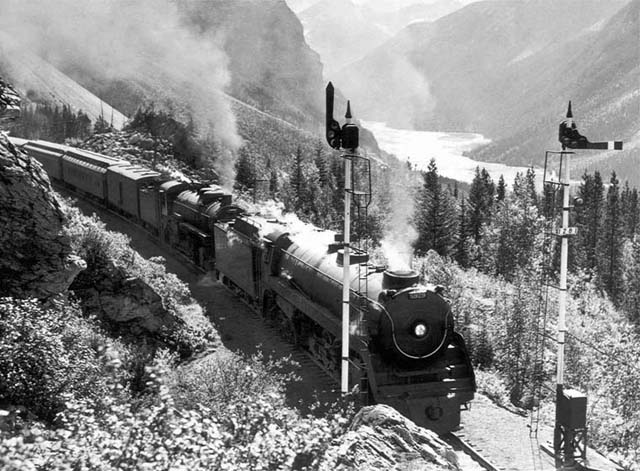
A booklet produced by the Canadian Pacific Railway in 1906 titled "Proceedings of the Meeting of Western Lines Officials held at Field, British Columbia, contains a selection of articles and discussions about the railway's operation. This month's article from that booklet, "Block Signals", written by Frank Lee, Division Engineer Central Division Canadian Pacific Railway, and containing additional comments by railway officials is reprinted here for your education with the addition of some appropriate images.
One of the most difficult questions for the human animal to decide upon is, what will some other animal do under certain given conditions. It can readily be seen, what an enormous opportunity for speculation is opened up, when two or more persons try to decide, how some other third party will act when exposed to certain conditions.
Discussions of signalling questions must of necessity often be based solely upon that almost indeterminate quantity, "the human equation", and for this reason such discussions are often criticized as being too theoretical. Also because of this, arguments brought forward in support of some features of signalling are less likely to appeal to one, who is not familiar with the subject, than to one who has made it a study. Perhaps no doubt it is for the same reason, that we often encounter the feeling, that signalling in general and interlocking in particular, is closely associated with the occult, black art, or slight of hand. None of these views however is correct, as all signalling is based upon well defined principles, and the signals themselves follow fixed physical laws prominent among which is one, that made Sir Isaac Newton famous, or at least helped to do so.
The commencement of signaling may be said to begin with the use of the locomotive, for it soon became manifest, that something would have to be devised, not only to prevent collisions between trains, but to give information to engineers regarding the position of switches and the right to go ahead. Many forms and devices were of course used in those early days, few of them being seen today, but which, as in the development of the locomotive, became stepping stones to things much better.
As each road or superintendent preferred their own devices to those of others, it followed as a matter of course, that the practice was very varied, so much so in some cases, that the safety signal on one road was used as the danger signal on the other. Naturally enough this state of things brought about many serious accidents, and finally resulted in a meeting being held by those interested, for the adoption of a standard form of fixed signal to be used by all roads. The choice fell upon the "semaphore", a signal which indicated by position and not by its form or colour.
It is not my intention to go into the history of signalling but I am very anxious that it should be understood how important "uniformity" is not only throughout our own road, but also with any road, with which we are liable to come in contact.
The entire question of standards and uniform practice was by no means solved at the meeting referred to above, but it was a start in the right direction, and the dream of the signal engineers today is the adoption by all railroads on this continent of a standard, which will be uniform in whole and in part.
Some railroads have preferred to neglect the feature of uniformity of signals for reasons of economy, and although extra expenses must be born in order to obtain such a desirable result, the great advantage in relieving the engineer's mind and giving him much less to think about should certainly have some capital as well as operating value.
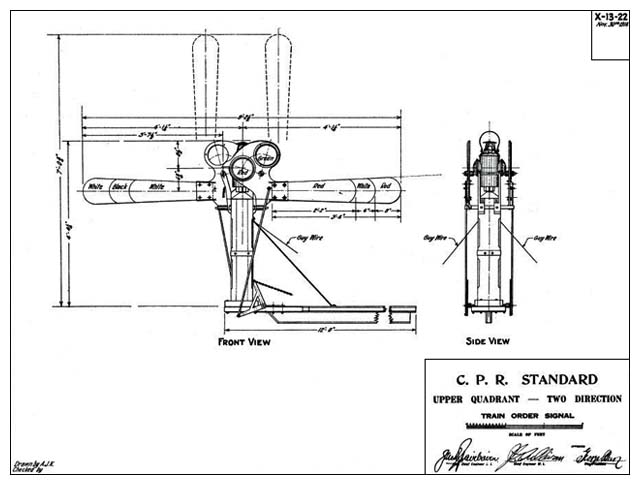
The C.P.R. has been using train order signals and to a certain extent interlocking signals, but the highest form of signalling usually comes in with block signals, which are specially designed to control the movement of heavy traffic, operated at high speed.
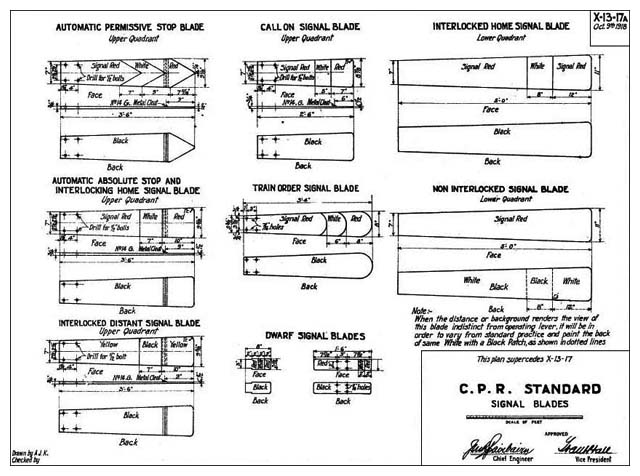
Block signalling, therefore, seems to present the heaviest problems, for here our old friend "the human equation" has less time to act, and his indefineability is thereby proportionately increased.
There are here general methods of operating block signals under which all the different systems of visual systems may be classified. These are called the "Telegraphic", the "Controlled Manual", and respectively the "Automatic".
With the telegraph block, the equipment of a station consists, primarily, of a signal for controlling trains, which although preferably of the semaphore type very often is not, and a wire used in connection with the ordinary telegraph instruments, or an electric bell for conveying the information necessary to properly work the block. The telegraph instruments of a division may all be on the same wire, in which case it can only be used by one operator at a time, and every other operator can hear what is being said, or else the wire may be run from one station only to the next and thus be a local wire and ready for use at all times.
That there is an essential difference in the manner, in which those two arrangements are operated, can be seen at once, although the result desired is in the main the same in both. With the first the dispatcher is expected to keep track of the operators and see that they properly report to the stations on either side of them the arrival and departure of trains. The dispatcher may be expected in some cases to give an order for the "clearance" of each signal, this making him entirely responsible for the blocking of trains and allowing the operators no discretion in the matter. With the second arrangement, where there is a local wire, the operator is alone responsible for the proper blocking of trains, reporting their arrival and departure to the stations on either side of him and clearing the signal only when the block is clear. There is of course with this latter arrangement the usual dispatcher's wire in each office, but it has nothing to do with the block system, and is only used by the operator to notify the dispatcher of the movement of trains.
Of the two arrangements the latter is much the better plan, as the dispatcher is then relieved from the routine work of blocking trains and can therefore devote his time to the general operation of the division.
In regard to permissive blocking with a telegraph block system the method most generally adopted is to put the entire control in the hands of the dispatcher and allow the operator to give a "caution" or permissive signal, only when so authorized by him. If condition of weather and track are favorable, permissive blocking is frequently made use of for freight trains. But between passenger trains the absolute block is maintained, unless exceptionally good reasons present themselves for doing otherwise.
That a system of signals operated through the means of communication afforded by the telegraph instrument is cheap and in every way advantageous, is clearly proved from the fact of its having been so widely adopted by roads that apparently could not afford to spend money on anything not absolutely necessary. One wreck will very often pay for a good many signals and the few extra operators required to work a block system, so that by drawing on one's imagination sufficiently as to the size of the wreck, it is very easy to figure out a great saving to any road. A system of block signals is certainly a much better arrangement, than is any practice of flagging trains, but the trainmen must be properly educated as to the extent of the protection afforded by the system and not look for it to do more than it is intended to do. That is, flagging is necessary even if the track is in the block signal district.
While undoubtedly there are dangerous situations, which may arise with the use of the telegraphic block from lack of a more complete equipment, it is certainly a great help to the dispatcher and a protection against collisions.
That engineers have run by signals when they were at danger, that operators have allowed trains to enter blocks when they were not clear, accidents being caused thereby, has resulted in a close adherence to the rules on the part of the men and stricter discipline on that of the officers. But the act still remains, that where a human agent is used, he is liable at times to fail, and the greater the precautions taken by mechanical means and by using two men instead of one, the less likely it is that mistakes will occur and accidents happen.
Work in this direction has resulted in the development of a system, in which the labour of two men working in conjunction with each other, is required to clear a signal and admit a train to the block. This method is called the "Controlled Manual", which is briefly described as follows:
The station signals are operated by interlocked levers, which are electrically connected with the levers of the next station in such a way that the signalman at one station cannon clear his signal until the signalman at the next station has released his levers, so that he can work them. There is of course a system of bell signals or otherwise between adjacent signal stations to allow the signalmen to communicate with each other.
From this it is seen that only through the efforts of two men, one at the beginning, and other at the end of the block, can a clear signal be given.
The blocking of trains by this method of operation is of course much better and safer than one where no check is put upon the operator, so much so that many prominent men believe it to be the best system of those in use today. But with all this the fact remains, the personnel factor is a necessary part in the operation of the plant and just so long as this is the case, mistakes will occur.
While men may have the best intentions and strive faithfully to perform their duties, error is an essential part of human action, and sooner or later the time will come, when mistakes will be made. Any system that will do away with the personal factor and at the same time give as reliable indications must certainly be in the line of progress towards that perfection and absolute security, which all systems strive to attain. The objection to an automatic signal, that because no one is on watch the signal may be disregarded, is not valid, for all that any of the systems are designed to do, is simply to indicate the condition of the block controlled by the signal. In any case faith must be placed in the engineer that he will obey such signals, for "A man will give all that he has for his life", and it is not likely that an engineer of sound mind will knowingly run into danger.
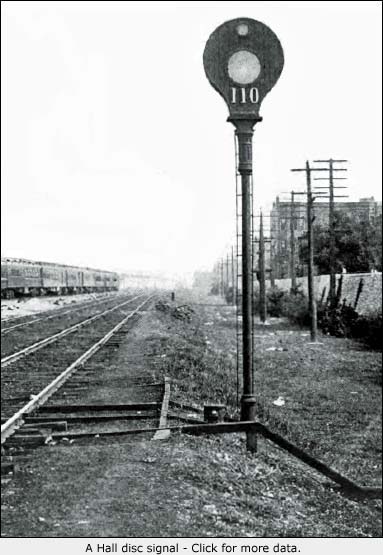 There are many Automatic electric signals in use, all of which can be classified under two distinct heads. Those which give colour indications, such as the Hall enclosed disc signal, and second, the regular semaphore or position signal. There is practically no difference in the manner, in which the two systems are operated, both being controlled by a current of electricity running through the rails, which is acted upon by the train. The Hall disc signal is rather cheaper than any of the automatic semaphore installations and probably is quite as reliable in its indications, this feature makes it very attractive on many roads, while other roads consider that there are great objections to using any but the semaphore type of signal and are willing to go to extra expense in order to have a uniform style of signal throughout. Certain it is, that both of these systems are coming more into use every day. They are also giving results both in the matter of expense and the expeditious handling of trains, that other systems cannot approach.
There are many Automatic electric signals in use, all of which can be classified under two distinct heads. Those which give colour indications, such as the Hall enclosed disc signal, and second, the regular semaphore or position signal. There is practically no difference in the manner, in which the two systems are operated, both being controlled by a current of electricity running through the rails, which is acted upon by the train. The Hall disc signal is rather cheaper than any of the automatic semaphore installations and probably is quite as reliable in its indications, this feature makes it very attractive on many roads, while other roads consider that there are great objections to using any but the semaphore type of signal and are willing to go to extra expense in order to have a uniform style of signal throughout. Certain it is, that both of these systems are coming more into use every day. They are also giving results both in the matter of expense and the expeditious handling of trains, that other systems cannot approach.
The method pursued in the operation of an automatic electric signal is very simple, the indication of the signal being positive: A train finding one at danger, stops, when the signal clears, it proceeds. As the blocks are generally short and trains can be run very close together, the blocking of trains is absolute, and no permissive blocking is provided for. Apparently the only rule necessary is "obey the signal", but in practice it is found, that they like everything else about a railroad, occasionally get our of order and give a false indication, that is they indicate danger when the block is really clear. If some provision was not made in the rules to cover such cases, it would result in the tying up of the road until the signal was repaired. Practice on different roads varies in the rule adopted for the guidance of trainmen, when a signal is found at danger owing to the character of the country, grades, curves, etc., but the general practice is for a train to stop for two or three minutes and then proceed as under a caution signal to the next clear signal.
Signals of this type can be used very advantageously on the C.P.R. for yard limit purposes and when we compare the working of such a signal for the usual style of yard limit semaphore in use on this road, we find a great many of our present difficulties eliminated.
The advantage of the Automatic over the Manually operated signal was aptly stated by a railroad Superintendent, when he said, "The Manual block sometimes goes to sleep, sometimes gets drunk, sometimes becomes insane, and almost always lies when it gets into trouble. The Automatic is unable to do these, were it so inclined."
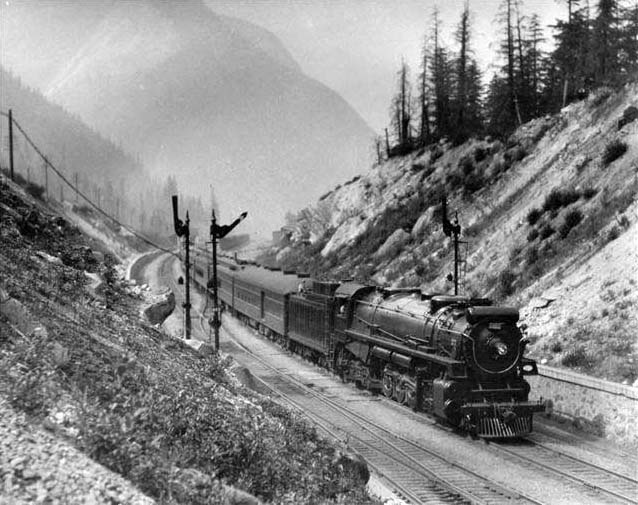
(single tracked in 1959) Connaught Tunnel - Date/Photographer unknown.
Mr. G.J. Bury - In order that accidents to trains standing at stations may be averted, we submitted this year an appropriation of $30,000.00 for the purpose of applying yard limit electric signals at stations on the Central Division where the view approaching is obscured.
I have operated divisions under two systems, the yard limit system as we have it in the west, and the semaphore system in the east, and the accidents under both were about alike. The reason for so many accidents under semaphores is that no one in particular is held responsible for attending to them. In some places it is the agent's duty and he as so many other things to attend to that he frequently neglects to operate the semaphores. At night, when the agent is not on duty, the work of operating the semaphores devolves upon the trainmen, and there is danger of an accident before they get to the lever.
On the River Division of the Milwaukee, they have the telegraph block. Since they but it into operation they have had no accidents, but as a result, the number trains run has been reduced considerably.
Mr. R.R. Jamieson - Some years ago we were very much handicapped by passenger train movement into Windsor Street Station, Montreal, and to overcome the delays, the Hall Electric Automatic Signal (disc shaped, with colour signal) was installed. This system worked most advantageously, and it seems soon that on Western Lines we are approaching the time when we will find it necessary to adopt some such signal system, especially for short distances. One case in point is the piece of track between Calgary and Calgary Junction, there being two branches leading off the main line from the latter station. There is a very heavy movement of freight engines and yard engines in addition to passenger trains between these points.
The Automatic signal is, no doubt, more expensive to install but in the operation it must be economical. While I do not think we have reached the point when it would be economical to adopt the signal system in a general way on any section of the Western Division, I believe we are rapidly coming to it. The Hall system has been found efficient, and so far as my knowledge of the conditions on Western Lines goes, it would be a good system to install for short distances.
Mr. Frank Lee - I should like to enlarge on some points in this paper. If we have a poor signal we might better have no signal at all, and if we decide to adopt any signal, especially the automatic signal, we must thoroughly consider the cost, not only in the construction, but in the maintenance, because such a system if it is not properly maintained, is a menace to a road rather than a benefit. The question which should be decided is whether we should adopt the colour signal or the position signal. The system in use between Windsor Street Station and Montreal Junction is the disc signal, which is a colour signal, and perhaps some of you have noticed that sometimes when the sun happens to be back of such a signal the position is not very clear. The position signal is more expensive to install, but on the other hand, it is a uniform signal with that which we find on our train order signals, and interlocking plants. I should be glad to hear some expression of opinion from the gentlemen present as to their ideas of the relative advantage of the colour signal and the position signal.
Mr. A. Price - On Western Lines the greatest density of traffic at the present time is between Fort William and Winnipeg. I understand from Mr. Lee that the Automatic block signal, which is to be installed to be used as yard protection, can be utilized as a block signal when the line is double-tracked. I do not think it would be wise to install the signal at every station at the start, but would favour setting it up at terminal points and at what we confider very bad places for trains meeting on account of obscured view. Aside from every other consideration, we must not lose sight of the fact that the yard limit signal displayed at "stop" requires a train to be brought to a stop before passing it, and as Mr. Marpole pointed out in his paper this morning, it costs something like 48 cents to stop a train of 500 tons. There has been a lot of data submitted in reference to this item, and in the case of freight trains such as we handle, I am inclined to think the cost would amount to something like 75 cents per stop. This is something that has to be reckoned with because it is occurring every day and every hour of the day.
Mr. H.E. Beasley - Do I understand that in the proposed block system the semaphore is to take the place of the yard limit board and prevent a stop? Is that the idea Mr. Price?
Mr. Price - Well, that was the point that I wished to make.
Mr. H.E. Beasley - If a semaphore will not stop a train, why a block will not do it, that is, a signal will not do it, and so the only object we will gain by introducing the block signal will be to allow trains to go through station limits without stopping.
It seems to me it is only a matter of time before it will be necessary for us to adopt some sort of block system in order to ensure our trains keep the requisite distance apart, especially through the canyons.
Of course, any system that is adopted should, as far as possible, be made standard.
Mr. F.F. Busteed - I agree with what Mr. Price has said with regard to the signals being installed so that we can take advantage of them when the second track is laid.
As to the type of signal we should adopt. I have not given this matter much thought. I think, however, it is a question that will bear discussion in order that we may find out which would be the safer. I fully agree with the idea of installing signals at junction points and where the traffic is congested.
Mr. W. Cross - While I cannot pretend to say from my experience which of the signals we should adopt, I know we have men in the room that can answer the question from the stand point of the engineer. In speaking some time ago to an engineer who runs a fast train on the Grand Trunk between Montreal and Belleville, he told me that at one point on the road at which the ordinary semaphore is obscured, if he is on the alert and can catch sight of that signal he has a positive assurance of safety, but if he does not happen to be on the alert at that particular moment, he passes the point at which he can see the signal, and he is right onto the danger signal before he has time to stop his train. This, I think, is the object of the position signal. However, we have men here who can tell as to whether the colour or position signal would be the better.
Mr. Chairman - You, Mr. Brownlee, having been an engineer, ought to be able to say a few words on this subject.
Mr. J. Brownlee - Not having had any experience in the block signalling system, I should not like to express an opinion as to whether we should adopt the colour or position signal. In the colour, of course, there is always a chance of the engineer mistaking the colour, especially if his colour sense is not good. As against this, however, in stormy weather when everything is covered with snow, the position of a signal is liable to put the engineer out.
Mr. R. Barnwell - Some years ago on the Great Northern in England a very lamentable accident occurred through the arm on a signal at Huntington being weighted down by heavy snow, giving an "all right" signal instead of remaining displayed at "stop", and this caused the loss of a number of lives.
OKthePK Joint Bar Editor: The above example refers to a lower quadrant signal. I wish to point out here the difference between an upper and lower quadrant semaphore signal. The "stop" or "danger" aspect of a semaphore signal is indicated when the blade is in the horizontal position whether it be an upper or lower quadrant semaphore. Upper quadrant semaphores have a "fail safe" advantage in that should the blade be disconnected from its mechanical control, i.e. the wire or push pull rod, the blade will fall into the horizontal position due to gravity which is the most restricting aspect for the signal. For lower quadrant semaphores a failed blade will drop by gravity into a "approach" or "clear to proceed" indication.
Mr. G.J. Bury - It used to be on our road that if you did not see the semaphore blade it meant proceed. This has since been remedied, and the "all right" position is when the blade is at an angle of 60 degrees below the horizontal. (lower quadrant)
On some of the roads they are giving more attention to the targets on switches. Some of the roads have adopted a white disc to show switch set for main line, and a red arrow to indicate a switch set for a side track. I think we should adopt this system.
Mr. O.O. Winter - If you will permit, I will say a few words in regard to the switch question. In the beginning of my railroad career, over thirty years ago, we had the white disc to indicate that a switch was set for the main line, and it proved a great relief to enginemen and others to see these white discs showing up to an approaching train.
As Mr. Brownlee says, there are some good points about the colour signal, particularly at night, but in the daytime, if there is a severe storm it is sometimes difficult to see the colour, especially if snow sticks to the signal. I presume that has also been Mr. Lee's experience with this class of signal, and no doubt it is the reason why the position signal has been considered more effective.
Mr. R.R. Jamieson - Before the Automatic signal was installed in the neighbourhood of Montreal, this question was discussed. The prevailing system was the disc, the position signal just being introduced. It was thought that the semaphore, or position signal, might not operate satisfactorily on account of wet snow, etc., but my view now on the subject is that the semaphore or position signal is the best.
Mr. J.E. Schwitzer - I would prefer to have the signal arm rather than depend altogether upon colour. From personal experience I know that there are certain places where a man can look across a lake or plain and get a good view of the semaphore and can tell whether the line is clear or not, while he cannot sate definitely as to the colour of the signal, besides which, anything which changes its position from that in which it is customary to find it attracts ones attention quicker than a difference in colour.
Mr. J. Cardell - I might venture to point out a case in connection with a train I was once running. We had one or two semaphores, the semaphore arm was obscured by foliage. Now to remedy this, it was suggested that we have the ordinary signal arm changed to a white one so that it would show up distinctly. The Company saw the necessity of this and changed the colour, which overcame the difficulty.
Mr. O.O. Winter - While the positive Automatic Electric block signal is the most effective in preventing accidents, and also facilitates the movement of passenger and other fast trains more than others, it is so expensive that I doubt whether it would pay our Company to adopt that system now or until such time as there is a larger increase in the number trains run. It might, therefore, be proper to discuss some system of signals we night adopt to advantage on certain parts of the road, to eliminate the greater amount of danger, and at the same time facilitate the movement of traffic. I know from personal experience that a train can be operated safely with the telegraph signal. This system possesses the feature of the permissive block, which is very advantageous on a heavy traffic single line road. No matter what system may be adopted, except of course the automatic block, I would not favour clearing station limits for freight trains. We see by the current periodicals that on block signal roads they do have trouble at stations, and I believe, therefore, that freight trains would be required to reduce speed in approaching all stations.
We now require freights to pass through station limits, First District, at reduced speed, and notwithstanding the heavy traffic of last fall, which I believe was equal to anything heretofore handled on the system, we did not have a single rear end collision where restriction was enforced. That seems to be a very good record when we consider that forty trains per day and better were handled over a section, heavy trains too, and proves the wisdom of the action. I do not believe there is any better record to be found so far as avoidance of rear end collision is concerned. The adoption of the telegraph signal would involve the expense of additional operators only, and would therefore, be both cheap and effective.
Mr. G.J. Bury - The idea prevails that is will not be longer than two years until the Government at Washington will compel block signals on all roads running passenger trains.
Chairman - If there is no further discussion upon this subject, we will consider it closed. The time is soon coming when this Company will have to adopt some system of better protection to fast trains than has heretofore existed.
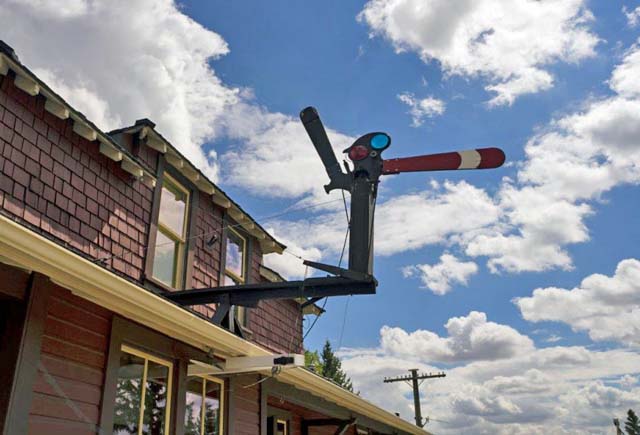
weight of the blade will cause the signal to fail in the most restrictive position - Date/Photographer unknown.
Canadian Pacific Historical Association
Hall Electric Automatic Disc Signal

